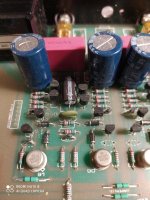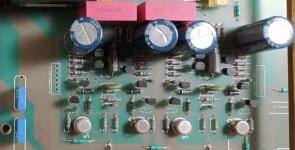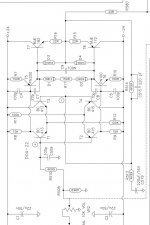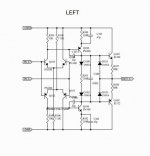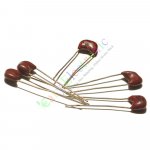Hi ! reading here and there in the forums a fairly common discussion is on how much, keep a design the same, the quality of active and passive components can impact on the general sound.
I am attaching a photo of a channel of a preamp that I have partially destroyed and therefore has no residual commercial value even if it is quite functional
I would like to ask if you spot any parts that could be replaced with others of the same value but of higher quality. I mean diodes and capacitors mostly.
I would keep the original transistors because I would not like to have operating problems
and the resistors saved the feedback one, if I can identify it obviously
A newer version of a preamp for example uses 1N914 (very cheap) instead of the 1N4001 on mine My guess is that the 1N914 is the better part ?
Even ceramic capacitors ... are there any quality series more suitable for audio uses ? the existing look quite cheap
Resistors seem ok.
As I said at the beginning I'm trying to understand if the game is worth the trouble.
I see this also as an opportunity to get familiar with a desoldering pump i have just purchased.
Thanks and best regards, gino
I am attaching a photo of a channel of a preamp that I have partially destroyed and therefore has no residual commercial value even if it is quite functional
I would like to ask if you spot any parts that could be replaced with others of the same value but of higher quality. I mean diodes and capacitors mostly.
I would keep the original transistors because I would not like to have operating problems
and the resistors saved the feedback one, if I can identify it obviously
A newer version of a preamp for example uses 1N914 (very cheap) instead of the 1N4001 on mine My guess is that the 1N914 is the better part ?
Even ceramic capacitors ... are there any quality series more suitable for audio uses ? the existing look quite cheap
Resistors seem ok.
As I said at the beginning I'm trying to understand if the game is worth the trouble.
I see this also as an opportunity to get familiar with a desoldering pump i have just purchased.
Thanks and best regards, gino
Attachments
Last edited:
the caps are almost all 22pF ...
Attachments
Last edited:
1N914 is cheap, yes, but so is 1N4001. OEMs buy these parts by multiple thousands, or even millions, and the cost is tiny. HAving said that, if they save a penny each on a million parts, that adds up to $10,000 savings. In your example, I doubt being "better" had anything to do with the part choice.
In my commercial shop, I do not stock 1N4001, or even 1N4004, I stock 1N4007. They work in place fo any of the lower voltage ones. The reason I don't stock the lower voltage ones is not money, it is using up drawers in my parts storage. One drawer covers all my 1N400x needs instead of a half dozen drawers or essentially the same part.
Point being, the choice of a part is not always something you can see on a schematic. They may have preferred the 1N914 because it was smaller and fit better on the board.
In my commercial shop, I do not stock 1N4001, or even 1N4004, I stock 1N4007. They work in place fo any of the lower voltage ones. The reason I don't stock the lower voltage ones is not money, it is using up drawers in my parts storage. One drawer covers all my 1N400x needs instead of a half dozen drawers or essentially the same part.
Point being, the choice of a part is not always something you can see on a schematic. They may have preferred the 1N914 because it was smaller and fit better on the board.
1N914 is cheap, yes, but so is 1N4001. OEMs buy these parts by multiple thousands, or even millions, and the cost is tiny. HAving said that, if they save a penny each on a million parts, that adds up to $10,000 savings. In your example, I doubt being "better" had anything to do with the part choice.
In my commercial shop, I do not stock 1N4001, or even 1N4004, I stock 1N4007. They work in place fo any of the lower voltage ones. The reason I don't stock the lower voltage ones is not money, it is using up drawers in my parts storage. One drawer covers all my 1N400x needs instead of a half dozen drawers or essentially the same part.
Point being, the choice of a part is not always something you can see on a schematic. They may have preferred the 1N914 because it was smaller and fit better on the board.
Hi ! thank you very much for your kind and helpful advice. I have to elaborate a little. This preamp is an old Bryston 0.5B line stage. Fwiu for line preamp duties Bryston as always used discrete op-amp designs.
Just as a reference i attach the schema of one more recent version
Unfortunately i cannot find a schematic of mine
My trivial guess is that the newer designs even if very similar in concept to mine have the better performance ?
Changing some diodes and caps i can do it
From your words i understand that there is no gain to expect ? 😱
thanks again 🙂
Attachments
The circuit in question probably works perfectly with any of the 3 choices - 914, 4001, 4007. The difference being that 914 is “faster” when switching, and the DC voltage drops between the three vary by tens of millivolts. If they are just for DC biasing, forget the switching speed. If tens of millivolts matter, you need the right one. Obviously, if they have been used interchangeably in different production runs, the small DC voltage change is immaterial.
I do keep a small stock of 1N4001. For output stage bias diodes in class B vintage power amps which call for them, and no bias pot is present. The extra millivoltage on the 4007 can cause bias to run high. I don’t want to have to place a other order just because bias is running a bit too high on a customers amp that I’m not getting a fortune to fix (people come to me to get stuff fixed cheap, because it’s NOT my source of income). If it’s adjustable the 4007 is used, because I buy by the 100. So it takes *two* parts drawers. Actually three, because there is also the UF4007.
I do keep a small stock of 1N4001. For output stage bias diodes in class B vintage power amps which call for them, and no bias pot is present. The extra millivoltage on the 4007 can cause bias to run high. I don’t want to have to place a other order just because bias is running a bit too high on a customers amp that I’m not getting a fortune to fix (people come to me to get stuff fixed cheap, because it’s NOT my source of income). If it’s adjustable the 4007 is used, because I buy by the 100. So it takes *two* parts drawers. Actually three, because there is also the UF4007.
Well, you can always replace your parts with Audiophile Approved [tm] ones.
The more you spend the better they sound.
Do not waste your precious brain on such trivial matters, let your wallet do the thinking.
Best sounding SS rectifiers?
Vishay is a respected manufacturer; if even THEY wasted ... sorry .... INVESTED time into this, then there must be some merit into the idea:
The more you spend the better they sound.
Do not waste your precious brain on such trivial matters, let your wallet do the thinking.
Best sounding SS rectifiers?
I just tried 11DQ06 in my DAC power supply and they are a big improvement over 1n4007. No complaints at all (so far)
Also tried Fairchild stealth FFP08S60STU in my DAC Valve output stage power supply and I don't like it!
The bass has no attack. and the midrange seems to be too prominent. (gave them 2 days to run in )
when I installed 11DQ06 in my DAC I noticed a considerable increase in clarity across all frequencies. I also noticed smoother (grain free) HF and mids.
The Fairchild Stealth diode made a very big negative impact on the sound.
Music lost its "sparkle" and "magic" - eveything became too even sounding. No part of the music "jumped out" and the bass disappeared. yes the highs were smooth, but everything else sounded "wrong".
Vishay is a respected manufacturer; if even THEY wasted ... sorry .... INVESTED time into this, then there must be some merit into the idea:
audiophile grade - Vishay
Vishay Intertechnology › audiophile_gradecomponents
AUDIOPHILE GRADE. Power MOSFETS. • Load and Signal Switches. • Switching Diodes and Rectifiers. • Capacitors. • Resistors. • NTC and PTC Thermistors.
1N914 is a small signal diode (fast) but 1N400x is a rectifying diode so it has a bit higher capacity but it is not a problem for this circuit. They both can be used as D1-D4.
The only difference is their different forward voltage drop. I guess 1N4001 has a lower Vfd. So with 1N4001 output transistors will have a lower quiescent current.
The only difference is their different forward voltage drop. I guess 1N4001 has a lower Vfd. So with 1N4001 output transistors will have a lower quiescent current.
Last edited:
Sorry, IMO this changing franzy is non sense to me, a recurrent DIYaudio fad swallowed by ignorants and spread by ignorants and snake oil vendors.
To improve an equipment can only be done by someone who really knows what he his doing and talking about.
To improve an equipment can only be done by someone who really knows what he his doing and talking about.
The art of engineering is being taken over by capacitor swappers and op-amp rollers.
I don't understand the need to improve a 30 year old pre-amp that uses obsolete transistors.
Repairing the pre-amp is one thing, but to start a complete re-design of a pre-amp from the early 1980's you would be better off to build or design one from scratch using modern day components.
This Doug Self pre-amp seems popular, it also has tone controls.
I don't understand the need to improve a 30 year old pre-amp that uses obsolete transistors.
Repairing the pre-amp is one thing, but to start a complete re-design of a pre-amp from the early 1980's you would be better off to build or design one from scratch using modern day components.
This Doug Self pre-amp seems popular, it also has tone controls.
The circuit in question probably works perfectly with any of the 3 choices - 914, 4001, 4007. The difference being that 914 is “faster” when switching, and the DC voltage drops between the three vary by tens of millivolts. If they are just for DC biasing, forget the switching speed. If tens of millivolts matter, you need the right one. Obviously, if they have been used interchangeably in different production runs, the small DC voltage change is immaterial.
Thanks a lot. Bryston for their gain blocks have delevoped a discrete op-amp
The different generations are very similar in concept and the newer ones have used 1N914 diodes. So my guess is that this diode is fine also for my older version. Another difference is that mine has a pair of bjts more.
If i will be able to use a sim i would like a discrete op-amp with the same front end and just a pair of darlingtons at the output. More minimalist.
But i do not know how to sim it. I have to study first. 😱
I do keep a small stock of 1N4001. For output stage bias diodes in class B vintage power amps which call for them, and no bias pot is present. The extra millivoltage on the 4007 can cause bias to run high. I don’t want to have to place a other order just because bias is running a bit too high on a customers amp that I’m not getting a fortune to fix (people come to me to get stuff fixed cheap, because it’s NOT my source of income). If it’s adjustable the 4007 is used, because I buy by the 100. So it takes *two* parts drawers. Actually three, because there is also the UF4007.
Thanks a lot again. The UF4007 is also another interesting candidate. But as the 914 are also so cheap ... i would like to try them also in the power supply ... i wonder if this is a sane idea 🙄
Well, you can always replace your parts with Audiophile Approved [tm] ones.
The more you spend the better they sound.
Do not waste your precious brain on such trivial matters, let your wallet do the thinking.
Best sounding SS rectifiers?
Hi ! this is a very important question. How much a better part can impact on sound. There is a big market of exotic parts like for instance capacitors with very high prices.
But maybe some parts have equivalents also cheap but generally better
Now i understand that the bjts used in mine are obsolete ... i am attaching one of the last version of the discrete op-amp with different parts
My guess is that the last edition of this OA is the most performing one ?
I notice that parts apart ... they have done it with a pair of bjts less. and i would like to do a mine one with another pair less ... using a darlingtons pair at the output
 But i have to study first
But i have to study firsti have to identify some 22pF caps to use ... what about these for instance ?Vishay is a respected manufacturer; if even THEY wasted ... sorry .... INVESTED time into this, then there must be some merit into the idea:
20pc Silver film MICA Capacitor 22pF 500V for hifi audio amps guitar amp tone | eBay
Attachments
What was wrong with the ceramic caps that were fitted ?
the look mostly ... 😱
1N914 is a small signal diode (fast) but 1N400x is a rectifying diode so it has a bit higher capacity but it is not a problem for this circuit. They both can be used as D1-D4.
The only difference is their different forward voltage drop. I guess 1N4001 has a lower Vfd. So with 1N4001 output transistors will have a lower quiescent current.
Hi ! thanks a lot. As i have said above it seems to me that Bryston have married this schematic for a long time changing only parts but not the overall concept. From a review i read the circuit has indeed a low distortion.
I do not know about its psrr but considering that Bryston top of the line preamps have a much more elaborated "external" psu my guess is that this circuit gains from cleaner voltages.
I am removing the internal main transformer to isolate it both mechanically and magnetically from the board. Now it is bolted with screws to the board
 i do not like it.
i do not like it. Adding another regulation stage before the existent will mean replace also the transformer with one with higher voltage. I am still undecided.
I have also a mains filter to try out at the transformer input.
Sorry, IMO this changing franzy is non sense to me, a recurrent DIYaudio fad swallowed by ignorants and spread by ignorants and snake oil vendors.
To improve an equipment can only be done by someone who really knows what he his doing and talking about
Yes you are right. Actually i am asking. I agree that not having even the schematic is almost a show stopper. This preamp is from '80s.
I cannot find a service manual
I will change only the parts i took out hoping that it works again.
Also because my mind tells me that the newer designs are better. They have one pair of bjts less ... maybe the next version will have another pair less. I love this trend heading to minimalist 🙄
Yes ! anyway if you put newer tyres on a old sport car you can improve its stability i guess. If newer parts more performant are available it is just to replace the older ones and keep the board.The art of engineering is being taken over by capacitor swappers and op-amp rollers.
I don't understand the need to improve a 30 year old pre-amp that uses obsolete transistors.
I have to write down a parts list ... with the bjts at least. I will leave resistors in place.
I see your point and you are right. For these reasons:Repairing the pre-amp is one thing, but to start a complete re-design of a pre-amp from the early 1980's you would be better off to build or design one from scratch using modern day components.
This Doug Self pre-amp seems popular, it also has tone controls
1) it is indeed a 40 years old design with parts probably obsolete
2) the newer versions of this circuit are similar in concept but different in parts number, my guess is that better parts have provided better performance with fewer components ? maybe the next version will have even less parts ?
3) what seems the weaker part is the power supply ... a very basic PSU using off-the-shelf IC regulators. The newer models up in the brand's line have an external much more substantial and complex power supply.
So i have decided to keep it as it is and replace only the parts that i have taken out. Hoping that it will work again of course.
Thank you very much indeed.
....For the diodes the choice would be the fast 1N914....
In this plan, those diodes never turn off, so "speed" is a total non-issue.
SPICE would tell you that IF you knew to ask.
1N914 in a power supply are very likely to BURN UP. Worst-case they do not burn-OUT but instead burn-up a power transformer.
It maybe would help to understand things before randomly "improving".
Any NP0/C0G ceramic cap will do.I do not know what to use for the 22pF caps
- Home
- Design & Build
- Parts
- Would you change anything ?
